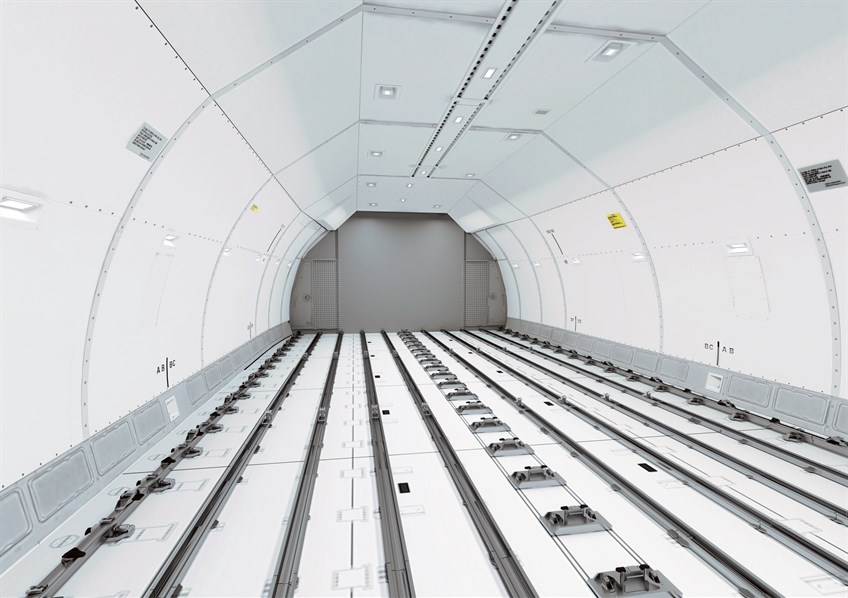Cargo compartments in aircraft had some accidental and incidental events in the history of civil aviation that led to the definition of some risk sources in the cargo compartment, and hence developing standard specifications and procedures during aircraft manufacturing and operation that needs to be met in order to prevent any hazardous area being created inside the cargo compartments.
One of these risk measures is the flame ignition prevention and fire suppression, and in order to avoid such a risk, researchers and engineers concluded that cargo compartment walls, floors and ceilings must be made of fire-resistant materials and that the compartment must be sealed very well. As a result, cargo compartments floor, wall and ceiling panels are designed to be manufactured using fire resistant sheet materials, these sheet materials are termed Cargo liners.
In the unlikely case of a fire, the main purpose of airplane cargo bay liners is to stop the spread of flames, smoke, and hazardous gases (FST) from the cargo compartment. The secondary purpose is to give the cargo bay area a hardy, durable interior surface that can withstand repeated high impact from unsecured passenger bags and sliding wear from large, heavy boxes, crates, and palletized goods.
Types of Aircraft Cargo Liners
Cargo liners are mainly classified based on the cargo compartment type, for a cargo compartment equipped with a cargo loading system, the liners used are sheet material liners along with pallet liners, while for bulk cargo compartments, sheet material liners only are used. Cargo liners can also be divided into different types based on two classifications: the shape classification and the material classification. For the shape, the following cargo liner types can be used on aircrafts:
- Drum type Cargo liners
- Barrel type Cargo liners
- Box/Container type Cargo liners
- Gaylord Cargo liners
- Tote Cargo liners
Also, the cargo liners used in civil aviation aircrafts can be manufactured from the following materials:
- Aramid paper reinforced phenolic (Nomex) honeycomb core
- Kevlar N636 reinforced phenolic honeycomb core, which offers high strength characteristics when compared to Nomex
- Fiberglass mat reinforced, chemical resistant polyester lab table-top overlay
- Woven fiberglass cloth reinforced acrylic laminate
- Woven fiberglass cloth reinforced phenolic laminate
- Woven fiberglass cloth reinforced polyester, general purpose cargo liner
- Woven fiberglass cloth reinforced polyester, high abrasion/ wear resistant cargo
- Unidirectional fiberglass reinforced epoxy with White Tedlar both sides high impact resistant cargo liner
- Aluminium facings/ aluminium honeycomb core sandwich panel (Black and Hill 1983)
Features & Design Considerations
Aircraft cargo compartment lining material must feature the following (at least):
- Material that offers protection from all types of wear, tear and impact loads that will result from loading and offloading the compartment with luggage and pallets.
- Must be custom molded specifically for the cargo compartment in order to exploit as much as possible of the compartment space
- Easy removal and installation procedure to gain access to any aircraft components beneath, above or behind the liners
- Perfectly sealing material that helps contain any spillage and guiding the spilled liquid to safe drain points
- Easy to clean
- Material must be resistant to skidding in order to decrease the possibility of loose luggage risk
- Must be durable and tough to help preserve the cargo compartment
The lives of the passengers in the passenger compartment may be at danger if the cargo compartment fire escapes. As a result, to comply with the airworthiness code, the cargo compartment liner must pass the oil burner test and be able to contain a fire.
The oil burner test is conducted under extremely difficult conditions for the cargo compartment liner. The typical cargo compartment liner design certainly couldn't satisfy the criterion of resist-flame burn-through due to the high temperature and prolonged burning period during the test. Therefore, while conducting the liner design based on resist-flame burn-through, it is imperative that the features of this test be fully taken into account in the early stages of design.
Metal and composite materials make up the majority of cargo liners. The vast area's plate-type portion often selects composite plate, whereas the portion utilized to attach and fasten other components typically selects metallic material.
The interior cargo panels should typically be able to withstand a fire's burn through depending on the composite material selection. Therefore, it is advisable to use an edge banding glue that takes longer to ignite, melts more slowly, and does not easily form drips. The inner panel utilizes more adhesive when the edge banding is larger, which causes the panel to burn longer or more readily. Therefore, by lowering the amount of edge banding, interior cargo panels can become more resistant to fire burn-through.
The melting point of aluminum alloy, when used as a choice of metallic material, is often no more than 660 °C, while the flame temperature in an oil burner test can reach 927 °C. Therefore, in contrast to the typical aluminum alloy used in conventional passenger compartment interior design, metallic pieces are typically employed to bordure the edge of the panels or to link two panels together at the lap joints in the visible side of the cargo compartment. Titanium alloy or ornamental laminates are often chosen by the layers that press the edge or fill the gaps. Silicon rubber gaskets and other luggage compartment accessories are frequently quite simple to ignite. Therefore, it is not advised to utilize accessories on the ceiling. If the ceiling has to be sealed, do it by sticking sealing tape to the wall of the compartment (MITRA 2023).
Advantages & Challenges
Cargo liners offer the following advantages:
- Provide a uniformly shaped and contained area for the largest possible volume that can be used to store the luggage or pallets
- Provide sealed area that prevents leakage of any liquid spills outside the bay
- Provide tough and reliable material that can withstand impact and friction loads
- Provide an air-tight and fire-proof bay that prevents fire spreading and offers fire oxygen starvation.
- Provide an air-tight compartment that can contain fire extinguishing materials during fire suppression process, and hence increase extinguishing efficiency and decrease extinguishing time
The advantages listed above also resemble the challenges that the industry faces in order to develop perfect cargo lining materials that perform the required job. Selecting a material that can withstand the weight, impact, and friction loads and at the same time to be air-tight and fire resistant is a very challenging task to the cargo liner manufacturers and suppliers. Also, installation and assembly of cargo liners and sealing them with the suitable type of tape is another challenge that faces the aircraft operator or airliner (Zhang 2023).
Another difficulty is that the liners and panels' ability to survive burning during a fire is their fire defense function. This feature makes sure that there are no fires or dangerous smoke or fumes in the passenger cabin. It is obvious that preserving airtightness in the event of a fire depends on the linings' ability to withstand flames.
The panels and other materials used in the construction of the cargo compartment liner must fulfill the flame resistance capabilities as stated by airworthiness requirements, which is one last obstacle. A set of production standard panels must be exposed to flames at a temperature of 927°C (or 1700°F) as part of a rigorous and in-depth process to prove conformity with this specification (J. W 1953).
Technological Innovations & Future Trend
Airworthiness standards now include a design requirement for cargo compartment fire protection that has evolved to take into account safety lessons discovered as a result of several unfortunate occurrences.
These days, airtight and fireproof cargo compartment linings are integrated with fire detection and suppression systems as the primary elements of cargo hold design that safeguard passengers and aircraft from a cargo hold fire. A cargo compartment lining includes the cargo door lining in addition to the other composite panels that make up the ceiling, sidewall, floor, and partition.
Maintaining the cargo compartment lining's condition is crucial for safety. Ground personnel should check the lining on each aircraft turnaround in addition to the regularly planned inspections.
Use of improperly maintained or out-of-contour shipping containers is the major reason for lining deterioration. Incorrect usage of these panels as access panels during airplane maintenance operations has also been documented to cause damage to decompression panels.
An uncontrolled fire on board is possible in the event that the cargo lining's airtight and fireproof characteristics fail. The identification of any damage to the cargo liner may therefore result in operating constraints, such as the requirement to fly with the cargo hold empty or devoid of flammable or combustible items (NEUMANN, et al. 2018).
References
Blake, David R., and Richard G. Hill. 1983. "FIRE CONTAINMENT CHARACTERISTICS OF AIRCRAFT CLASS D CARGO COMPARTMENTS." Springfield.
J. W, Killan. 1953. "The future development of cargo liner." Royal Society of Arts.
MITRA, EBARINDO WAHANA. 2023. "Products Available from PROFESSIONAL PLASTICS, INC." SUBUR JAYA AVIATION.NEUMANN, Juergen, Konstantin KALLERGIS, Konstantin KALLERGIS, and Konstantin KALLERGIS. 2018. "Protecting Aircraft and Passengers from Cargo Fires." Airbus Safety First.
Zhang, Huan. 2023. "Design Method of the Civil Aircraft Cargo Compartment Interiors Based on Resist-flame burn through." J Phys.: Conf.





Comments
There are currently no comments, be the first to comment.